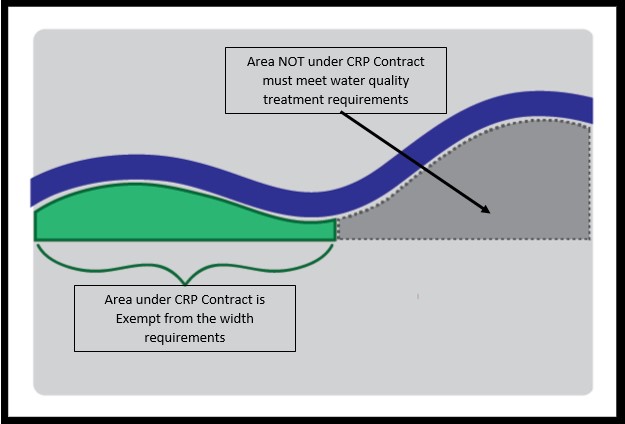Purpose and Considerations
This guidance is for local governments charged with implementation of the Buffer Law where Conservation Reserve Program (CRP) contracts are in place. Subdivison 5 of the Buffer Law provides an exemption to the buffer requirements for lands enrolled in the federal Conservation Reserve Program “to the extent these exemptions are not inconsistent with the requirements of the state shoreland rules adopted by the commissioner pursuant to section 103F.211” (Minnesota Statutes §103F.48, Subd. 5).
Statutory References
Minnesota Statutes §103F.48, the Buffer Law, requires buffer widths based on the classification of the waters identified on the Buffer Protection Maps. These widths are defined in Minnesota Statutes §103F.48, Subd. 3(a) as follows:
(1) For all public waters, the more restrictive of:
a) a 50-foot average width, 30-foot minimum width, continuous buffer of perennially rooted vegetation; or
b) the state shoreland standards and criteria adopted by the commissioner under section 103F.211; and
(2) For public drainage systems established under chapter 103E, a 16.5-foot minimum width continuous buffer as provided in section 103E.021, subdivision 1. The buffer vegetation shall not impede future maintenance of the ditch.
However, subdivision 5 of this same section provides an exemption to these requirements for lands enrolled in the federal Conservation Reserve Program “to the extent these exemptions are not inconsistent with the requirements of the state shoreland rules adopted by the commissioner pursuant to section 103F.211” (Minnesota Statutes §103F.48, Subd. 5).
Implementation Guidance CRP Exemptions
Riparian buffer areas enrolled in CRP are exempt from the buffer width requirements of the Buffer Law. This exemption is not intended to prevent eligibility of lands for application and future enrollment into the CRP program.
- Riparian land currently under a CRP contract is exempt from the width requirements identified in the buffer protection maps and maintains its exempt status if it is reenrolled into the CRP program prior to contract expiration.
- Riparian land not covered by a CRP contract must meet the requirements of the Buffer Law independent of the area of land which is under a CRP contract or application. (see Example #1)
- The landowner or authorized agent or operator of the landowner may include riparian areas under a CRP contract when determining the average/minimum buffer width.
Implementation Examples
Example A) A Landowner is required to provide the water quality benefit comparable to a 50’ average width buffer based on the DNR Buffer Protection Map. A CRP assessment and enrollment calls for a 30’ wide area enrolled in CRP to address the resource concern and the landowner enrolls 30’. That land is exempt and does not need an additional 20’ average buffer width.
Example B) A Landowner is required to provide the water quality benefit comparable to a 50’ average width buffer based on the DNR Buffer Protection Map. A CRP assessment and enrollment calls for 120’ wide area enrolled in CRP to address the resource concern. In order to enroll in CRP the landowner/land needs to meet any/all associated CRP program rules. So it is unlikely the CRP program would offer CRP to only cover the 50’ width.
If the landowner chooses to enroll the CRP required 120’, they may use this area in attaining the 30’ minimum 50’ average width for the bank of the waterbody in areas that are not under contract on that parcel.
Lands on which a CRP contract has expired are no longer exempt, and require the water quality benefit provided by the prescribed buffer width as identified on the DNR Buffer Protection Map.

